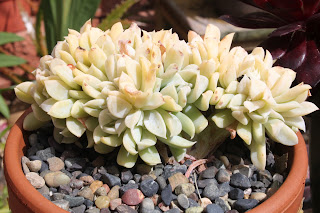This is the third update to the Seed Determination post....
A ten day trip out of town left me a little anxious about the fate of my seedlings. I had to figure out how to prepare them for survival on their own. Most seeds had already germinated, so I hesitated keeping them in baggies, yet the late summer high temperatures were due to arrive, so I also feared they would dry out without my twice daily misting routine. What to do?
I decided to place all of the pots in a large plastic tray with about an inch of small gravel covering the bottom. I poured a small amount of water over the gravel, then placed the entire setup in a large, white plastic bag, sealed it, and kept my fingers crossed!!
The first thing I looked at upon my return was my seeds. Carefully opening the bag, I prepared myself for what I expected to be pots of sand with no signs of life. On the contrary!! There were lots of tiny green blobs looking up at me and smiling. They did amazingly well. I was so relieved.
Despite the successes with this batch, the germination rate is pretty low. I would guess it at about 20%. Surprisingly, Lithops were the lowest and Faucaria the highest. I also had great luck with a couple of the cactus species, with an especially good showing of Echinocereus.
Below are the latest photos. I will post another update soon!
 |
| Echinopsis 'Epic' |
 |
| Faucaria kingiae 'Grahamstown' |
 |
| Argyroderma delaetii x patens |
 |
| Odontophorus protoparcoides |
 |
Echinocereus reichenbachii and
Echinocereus coccineus
|
 |
| Cephalophyllum spissom caespitosum |
Overview of seedlings

































